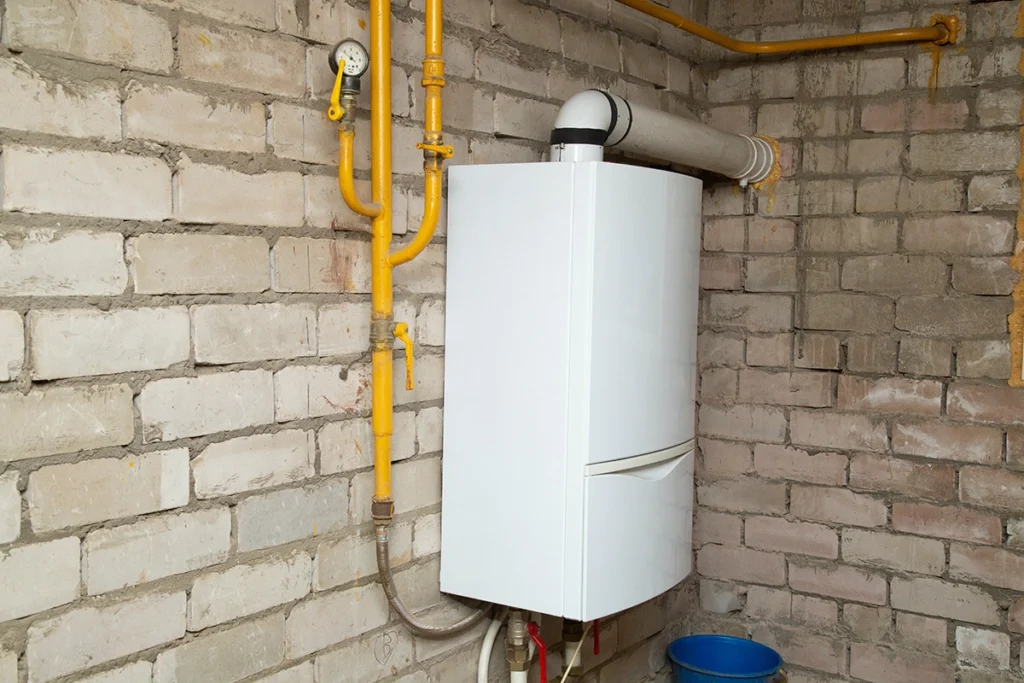Knowing how to flush a tankless water heater is one of the best ways to protect your system, maintain consistent hot water, and prevent expensive repairs. Because tankless systems heat water on demand, mineral buildup in Massachusetts—especially in areas with harder water—can collect inside the heat exchanger more quickly than many homeowners realize. When that happens, efficiency drops and your water heater has to work harder than it should. That’s why Efficiency Plumbing, Heating & Air in Hanover, MA is here to walk you through the process, explain why flushing matters, and help you know when it’s time to call a professional.
Why Learning How to Flush a Tankless Water Heater Matters
Even though tankless systems are known for long lifespans and high efficiency, they still need routine maintenance. Over time, limescale and mineral deposits from your water supply coat the internal components, restricting water flow and forcing the heater to run hotter, louder, and less efficiently.
If flushing is neglected too long, homeowners often experience:
-
Slower hot water flow
-
Short cycling or inconsistent temperatures
-
Error codes on digital displays
-
Increased energy consumption
-
Rumbling or vibrating noises from the unit
Understanding how to flush a tankless water heater not only prevents these problems but also helps your system last longer and operate more reliably throughout the year.
How Often Should You Flush a Tankless Water Heater?
Manufacturers usually recommend flushing tankless water heaters once a year. However, in areas like Hanover—where varying water conditions and older plumbing systems are common—homes with moderately hard water may need flushing every six months.
Although some homeowners perform basic maintenance themselves, regular professional flushing ensures the system is descaled thoroughly, sensors are inspected, and any early signs of trouble are addressed before they turn into bigger issues.
What You Need to Flush a Tankless Water Heater
Before learning how to flush a tankless water heater, it helps to gather the right tools. A standard descaling kit typically includes:
-
A submersible pump
-
Two washing machine hoses
-
A bucket (at least 5 gallons)
-
White vinegar or a tankless water heater descaling solution
-
Screwdriver to remove the service panel
Having these items on hand makes the entire process smoother and ensures you have what you need to circulate cleaning solution through the heater.
How to Flush a Tankless Water Heater: Step-by-Step Tips
Every tankless model is slightly different, so homeowners should always refer to the manufacturer’s manual. Still, the overall process is similar across systems. Here’s what it looks like:
1. Turn Off Power and Water Supply
Safety first. Because tankless systems have electrical components and gas lines, beginning with a power shutdown is essential. Turn off:
-
Electrical power to the unit
-
Gas supply (for gas models)
-
Cold and hot water valves
This prevents water flow and keeps the unit safe during maintenance.
2. Open the Service Ports
Most tankless water heaters have colored service valves—typically red for hot and blue for cold. Opening these ports allows the cleaning solution to circulate through the heat exchanger.
3. Set Up the Pump and Bucket
Place the pump in a bucket filled with vinegar or descaling solution. Connect hoses:
-
Pump to cold-water service port
-
Hot-water service port back to the bucket
This creates a loop where solution travels in and out of the heater.
4. Run the Flush Cycle
Turn on the pump and let the solution circulate for 45 to 60 minutes. This step dissolves mineral deposits inside the heat exchanger. Homeowners who regularly perform this maintenance will often see cloudy or foamy water at first—proof that the cleaning solution is working.
5. Rinse the System
After flushing with vinegar or descaler, drain the bucket and fill it with clean water. Run the pump again for about 5 minutes to rinse any leftover solution from the system. This prevents vinegar odors or lingering residue from entering the water lines.
6. Disconnect and Restore Normal Operation
When the rinse is complete:
-
Turn off the pump
-
Disconnect hoses
-
Close service valves
-
Open water supply valves
-
Turn gas and power back on
Once the system restarts, check for proper operation, verify hot water flow, and ensure no error codes appear.
When Flushing Isn’t Enough
Although knowing how to flush a tankless water heater helps prevent many common issues, it doesn’t fix certain problems. If your system still struggles after flushing, the issue may involve:
-
Faulty sensors
-
Scale buildup in other components
-
Blocked venting
-
Electrical issues
-
Burners or ignition failure
In these cases, a professional inspection is essential. Tankless systems contain sensitive electronics and safety devices that require trained expertise to diagnose and repair.
Benefits of Regular Flushing for Tankless Water Heaters
Consistent maintenance offers significant long-term benefits for Hanover homeowners. With routine flushing, your tankless system can deliver:
-
Better energy efficiency
-
Faster hot water
-
Lower utility costs
-
Reduced noise
-
Longer equipment lifespan
-
Fewer breakdowns
Because mineral buildup is the number-one cause of tankless water heater problems, flushing is one of the most cost-effective ways to protect your investment.
Why Professional Flushing Matters in Massachusetts Homes
Tankless systems behave differently depending on water quality, plumbing layout, and usage patterns. In Massachusetts—where older home construction and varying well water conditions are common—professional maintenance ensures deeper cleaning, proper diagnostics, and safer long-term operation.
Efficiency Plumbing, Heating & Air not only flushes your tankless water heater but also:
-
Checks for internal corrosion
-
Tests sensors and ignition
-
Inspects venting for blockages
-
Confirms correct burner operation
-
Looks for early signs of wear
This comprehensive approach keeps your system performing the way it should all year long.
Choose Efficiency Plumbing, Heating & Air for Tankless Water Heater Maintenance
Learning how to flush a tankless water heater gives homeowners a better understanding of their hot water system, but nothing replaces professional care—especially when you want to maximize lifespan, performance, and safety. Efficiency Plumbing, Heating & Air provides expert maintenance, full-system descaling, and detailed inspections for tankless water heaters across Hanover, MA and surrounding areas.
If your tankless unit is due for a flush, showing signs of slow heating, or hasn’t been serviced in over a year, call our team today. We deliver fast, dependable service that keeps your home comfortable and your water heater working at peak efficiency.





